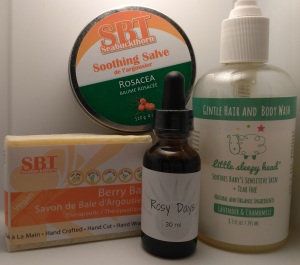While winter is known for giving many people a pink-cheeked look when they come in from the cold, those plummeting temperatures and harsh winds can be even harder on your skin when you have rosacea.

Yes, it can look cute when you have rosy cheeks when you just walk in the door from a brisk winter’s day but when the redness doesn’t go away and is joined by tightness, dryness, burning, itching and other unpleasant symptoms, it becomes clear that the right winter skin care for rosacea is a must.
You might have found what works for you in the summertime as you protect your skin from triggers and keep it gently cleansed and moisturized but colder weather typically requires a slight change in rosacea skin care products.
Believe it or not, this is true no matter where you live. Regardless of whether your winters send the mercury well below freezing or whether you live somewhere that remains comparatively mild, it is the difference in temperatures and humidity levels from one time of the year to the next that causes your skin to require different rosacea skin care products.
Wind, cooler temperatures, as well as air conditioning or indoor heating can all wreak havoc on your rosacea symptoms. Humidity, dryness and temperature fluctuations can require an extra layer of protection throughout the winter months. All this, on top of the stress many people feel around the holiday season when there are many different kinds of plans, gatherings, festivities and even just things to wrap up before the year comes to an end, can take its toll.
It also makes it more important to keep up with any treatments you are using, regardless of whether they are prescriptions, natural rosacea treatments or amber or red light therapy or both red and amber light therapy combined.
Winter Rosacea Symptoms Prevention Tips
Here are some great tips to help to keep your rosy cheeks and rosacea symptoms under control this winter:
 When the weather is extreme, try to stay in as much as possible. Very low temperatures and biting winds will only make things worse, fast. If you must head out, use a ski mask or scarf to keep your face protected.
When the weather is extreme, try to stay in as much as possible. Very low temperatures and biting winds will only make things worse, fast. If you must head out, use a ski mask or scarf to keep your face protected.- Be aware of your body temperature. It’s easy to get very cold and very hot in a matter of moments in the winter. Stepping inside homes, workplaces and malls while bundled up can rapidly bring on the heat. Heading out the door after being warm inside can strike you with shivers. Layer with loose clothing so you can always adjust how warm or cool you are.
- Pay attention to fabrics. Many people find their rosacea symptoms flare when they come in contact with certain fibers. One common troublemaker is wool. Take care to know what fibers are coming in contact with your face and watch for trends in irritations and flare-ups.
- Keep cool while inside. This is especially important when you’re doing things like cooking and baking. These activities feel so normal and everyday that we often forget how warm they can make us. Steam from pots and heat from stoves and ovens can rapidly bring on rosacea flushing. Take breaks from the heat by leaving the room – or at least the spot immediately in front of the oven and stove – whenever you can. Turn on the hood fan or an oscillating fan set on low, to move some of the heat around and keep the temperature within reason.
- Watch what you eat. Added sugars, salty foods, alcohol and other potential trigger foods abound when it’s nasty outside. This is especially true because hot foods and beverages are the most appealing when you’re trying to beat the winter chills. Try to limit the consumption of these foods as much as possible – if you can get away with a bite, go for that, instead of a whole portion – and try to wait for hot options to cool down a bit before you begin.
- Keep your stress levels as controlled as possible. Don’t overbook your schedule, complete tasks as early as you can, don’t procrastinate, make a priority of “me time” and stick to a bedtime and waking routine as though your life depended on it. The more relaxed you are, the calmer your skin can be.
- Maintain an extremely consistent winter rosacea skin care routine. Find the right rosacea skin care products for your unique skin type and symptoms as early as possible and stick to them – along with any treatments you’re using – without any exceptions.
 Sit back from the fireplace. Try not to sit too close to any specific heat source as it will only warm and dry your skin, increasing the risk of a flare-up or at least a deeper blush.
Sit back from the fireplace. Try not to sit too close to any specific heat source as it will only warm and dry your skin, increasing the risk of a flare-up or at least a deeper blush.- Consider using a humidifier if your home is especially dry in the winter. If you can’t touch anything metal without getting a shock or if your sweaters and hair are particularly zappy, this may be a sign that a humidifier could help – particularly if it’s run in your bedroom at night while your skin is doing most of its healing.
Consistency with rosacea treatments and skin care as well as avoiding triggers can help you to avoid the vast majority of flare-ups and discomforts.
Winter Rosacea Skin Care Tips
The hardest part of treating your skin during the winter is usually in developing and sticking to your rosacea skin care routine. The first step is to find the right products, which can be a struggle in itself but then you need to stick to it every morning and every evening without fail. No exceptions.
Moreover, for the first two weeks of virtually any rosacea product change, your skin will often flare-up and break out. This makes it very difficult to judge any rosacea skin care products within the first two weeks of use, as things often get worse before they get better. For most people, the key is to keep it simple. Use as few products as possible, choose formulas with very gentle ingredients and avoid most options with promises such as anti-aging, exfoliating and even anti-redness in some situations (as many anti-redness formulations are designed to mask the color without healing the skin underneath, which can actually worsen the situation over time).
Consider the following tips as you create your winter rosacea skin care routine:
 Gentle cleansing. Use an extremely gentle rosacea skin care product for cleansing. The goal isn’t to have a “squeaky clean” feeling once you’re done. Instead, the idea is to remove the dirt, unwanted bacteria, product and excess oils while leaving some skin oils in place. Healthy skin does have some oil left on it. You want your skin to be clean, not stripped. In most situations, twice-daily cleansing is all you need.
Gentle cleansing. Use an extremely gentle rosacea skin care product for cleansing. The goal isn’t to have a “squeaky clean” feeling once you’re done. Instead, the idea is to remove the dirt, unwanted bacteria, product and excess oils while leaving some skin oils in place. Healthy skin does have some oil left on it. You want your skin to be clean, not stripped. In most situations, twice-daily cleansing is all you need.
A low- or non-foaming, fragrance free, creamy cleanser is the goal. Watch out for alcohols and astringent ingredients as they should typically be avoided. The result should leave a thin film behind that will act as a moisture barrier to lock in this vital hydration.- Rosacea treatment. If you are treating your rosacea with a specific prescription or nonprescription topical cream or with amber light therapy and/or red light therapy, now is usually the best time to use it. Treatments are generally best used on a clean face, right after cleansing. That said, be sure to follow the directions of your doctor or dermatologist, or on the product package.
- Moisturizing. This is best done as close to cleansing as possible. If you are using a treatment, moisturize right afterward (unless the treatment includes the moisturizing or recommends against the application of additional products). If you are not using a treatment, moisturize immediately, when your skin is no longer damp but when it doesn’t yet have that fully dry feeling. An extremely gentle moisturizer is best. In the daytime, it can help if you choose one with an SPF if the sun is one of your triggers.
In the winter heavier creams, salves and oils are often more effective for preventing rosacea symptoms than the lighter lotions that are typically suited to warmer weather. This is the product most likely to need to be changed as a part of the rosacea skin care routine when moving from one season to the next and is the most likely to require that unpleasant transition period of about two weeks when breakouts and flare-ups can happen. Red light therapy may help to minimize the inflammation that is behind many of those symptoms and amber light therapy can help to calm the skin.
Set up a routine that will be appropriate for following the instructions on all these rosacea skin care products and treatments and stick to it without fail. Your skin loves routine and hates change, so the more you keep up the exact same patterns, the less likely you will be to have breakouts, flare-ups, and other unwanted symptoms.
*Please remember that I’m a rosacea blogger and patient with the condition, but I’m not a doctor. This is information I’ve compiled based on my own experience, but I’m not a medical professional or a skin care expert. For an official diagnosis or advice, please make an appointment to see your doctor!


Dear Julie when a topical cream that protects from thermal shock/stress will be invented??? I tried in the past during summer days the only product that said that was for anti thermal stress – called Melablock HSP SPF 50+ from Spanish Company Skin Tech- and what a big disapointment. No results. God help us. Maybe one day they will solve the problems from Earth first before flying to Mars. Take care. Panda hugs.
LikeLike